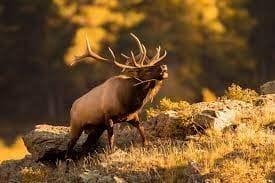The "elk rut" is the mating season of elk, also known as wapiti, which occurs annually during late summer and early autumn. During this time, bull elk engage in intense competition for mates, often vocalizing loudly and engaging in physical confrontations. The elk rut is a spectacular sight, drawing wildlife enthusiasts from all over to observe the impressive displays of dominance by the bulls.

An elk rut, also known as the mating season of elk, is a fascinating natural phenomenon that occurs annually in late summer and early autumn. The elk rut is an important event not only for the species but also for the ecosystem as a whole.
During this time, bull elks engage in intense competition for mates and display impressive acts of dominance, making it a spectacular sight for wildlife enthusiasts.
What is an Elk Rut? The elk rut is the mating season of elk, also known as wapiti. During this period, bull elks, which are the male members of the species, are at their most active and competitive.
The rutting season usually takes place from late August to early October, depending on the region.
The purpose of the elk rut is for the bulls to attract and mate with as many cows, or female elks, as possible. This ensures the continuation of the species and helps to maintain a healthy population.

The rutting season is also an opportunity for the bulls to assert their dominance over other males and to demonstrate their physical strength and fitness to potential mates.
Biology of the Elk during the Rut During the elk rut, significant changes occur in the behavior and physical appearance of the bull elks. These changes are largely driven by hormones and pheromones, which play a crucial role in attracting mates and establishing dominance.
Bull elks undergo a series of physical transformations during the rutting season, including the growth of antlers and the development of a strong, musky odor. These changes serve to attract potential mates and to deter other males from competing for the same cows.
Competition for mates and dominance displays are an integral part of the elk rut. Bull elks may engage in vocalizations, such as bugling, and physical confrontations, such as antler clashes, to establish their dominance over other males. The most dominant bull elks have the best chance of attracting and mating with a larger number of cows.
Importance of the Elk Rut to the Species
The elk rut is a crucial event for the species as it plays an important role in mating and reproduction. During the rut, cow elks come into estrus, or heat, and are receptive to mating with bull elks. This allows the species to continue and maintain a healthy population.
The rutting season also helps to control the population of elks by limiting the number of successful breeders. The competition among bull elks for mates ensures that only the fittest and strongest individuals are able to breed, thus maintaining the genetic health of the species.
Ecological Significance of the Elk Rut
The elk rut has a significant impact on the ecosystem as a whole. The presence of elks in an area can greatly affect the food chain, as well as the predator-prey relationships between different species. For example, the presence of elks can stimulate the growth of certain plant species, which can attract other herbivores and predators to the area.
The elk rut also has the potential to influence other species in the ecosystem, such as smaller mammals and birds, which may be attracted to the area to feed on the vegetation stimulated by the elks.
The ecological significance of the elk rut highlights the importance of conservation and wildlife management efforts. By preserving and protecting the habitats of elks, we can help to ensure the survival of this magnificent species and maintain the delicate balance of the ecosystem.
Observing the Elk Rut
The elk rut is a unique and exciting event that attracts wildlife enthusiasts from all over the world. To observe the elk rut, it is best to visit areas where elks are known to live, such as national parks and wildlife reserves.
It is important to follow safety precautions and ethical considerations when observing the elk rut. This includes staying at a safe distance from the animals, avoiding disturbing their natural behaviors, and respecting their habitats.
The best time to observe the elk rut is during the peak of the mating season, which usually occurs in late September or early October. To get the best viewing experience, it is recommended to arrive early in the morning or late in the evening, when the bulls are most active.

Conclusion
The elk rut is a remarkable event that showcases the strength and determination of the bull elks, as well as the importance of the species to the ecosystem. Whether you are a seasoned wildlife enthusiast or simply looking to learn more about the natural world, the elk rut is an experience not to be missed.
